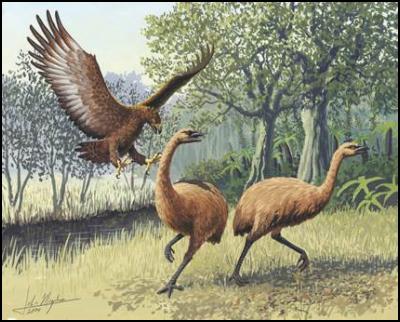Moa Diet Fits The Bill
Moa Diet Fits The Bill

Medical scanners, and the same software used to assess building strength after the Canterbury earthquakes, have revealed new information about the diet and dining preferences of the now extinct New Zealand moa.
Researchers from Canterbury Museum, the University of Auckland, Flinders University, the University of New England (Australia) and UNSW Australia, have discovered that the nine species of moa were able to co-exist because differences in the structure and strength of each species’ bills influenced or dictated diet. The findings have been published today in the journal Proceedings of the Royal Society B, London.
The moa, which roamed New Zealand until the fifteenth century, were herbivores and some of the largest birds to have ever existed. The largest species, the South Island Giant moa, weighed up to 240 kg whilst the smallest (the upland moa) was the size of a sheep. Until now scientists had thought that the huge differences in size between the species determined their foraging behaviour as well as what, when and where they ate (their ecological niche).
Canterbury Museum Senior Natural History Curator Professor Paul Scofield says the team took the most complete skulls of each species of moa from the collections of Canterbury Museum and Te Papa Tongarewa and scanned them using medical CT (Computed Tomography) scanners.
“We then produced highly accurate 3D models of each. This wasn’t a simple job as we didn’t have a single skull that was perfect so we used sophisticated digital cloning techniques to digitally reconstruct accurate osteological models for each species,” Professor Scofield said.
Using medical MRI (Magnetic Resonance Imaging) scans of exquisitely-preserved mummified remains made by Dr Peter Johnston of the University of Auckland, the researchers digitally reconstructed the muscles of each species. Software used by civil engineers after the Canterbury earthquakes to identify weak or unsound buildings, was then employed to test the strength and structure of each species’ skull.
These were compared to each other and to two living relatives, the emu and cassowary. The models simulated the response of the skull to different biting and feeding behaviours including clipping twigs and pulling, twisting or bowing head motions to remove foliage.
Dr Marie Attard of the University of New England says that the skull mechanics of moa were found to be surprisingly diverse. “The little bush moa had a relatively short, sharp-edged bill and was superior among moa at cutting twigs and branches, supporting the proposition that they primarily fed on fibrous material from trees and shrubs.
“At the opposite extreme, the coastal moa had a relatively weak skull compared to all other species which may have forced them to travel further than other moas in search of suitable food, such as soft fruit and leaves.”
Dr Trevor Worthy, a New Zealander working at Flinders University, says “until now we have been limited in assessing anatomical function to examining the external aspect of bones. This new technology allows us to bring new life to old bones and to get one step closer to understanding the birds they came from.”
"Little has been known about how New Zealand’s ecosystem evolved, largely because we know so little about how moa lived and co-existed." says Associate Professor Stephen Wroe of the University of New England. “This new research advances our understanding about the feeding behaviours of the moa species and their impact on New Zealand’s unique and distinctive flora.”
ENDS


 Bill Bennett: Download Weekly - ComCom Recommends Removing Rural Copper Regulations
Bill Bennett: Download Weekly - ComCom Recommends Removing Rural Copper Regulations Hugh Grant: Why Pay Equity Software Is Essential For A Strong Employee Value Proposition
Hugh Grant: Why Pay Equity Software Is Essential For A Strong Employee Value Proposition Electricity Authority: Electricity Authority Acts Quickly To Strengthen Security Of Electricity Supply Ahead Of Winter
Electricity Authority: Electricity Authority Acts Quickly To Strengthen Security Of Electricity Supply Ahead Of Winter School Lunch Collective: Compass Group New Zealand To Acquire Libelle Group Securing Healthy School Lunch Programme
School Lunch Collective: Compass Group New Zealand To Acquire Libelle Group Securing Healthy School Lunch Programme PSA: PPPs Pose Risks To New Zealand Workers
PSA: PPPs Pose Risks To New Zealand Workers Office of the Privacy Commissioner: New Research Shows Business Leaders Fear Being On The Hook For Others’ Privacy Breaches
Office of the Privacy Commissioner: New Research Shows Business Leaders Fear Being On The Hook For Others’ Privacy Breaches



